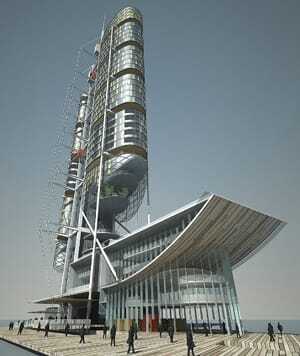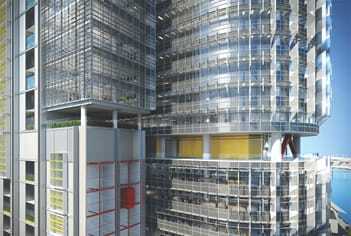From behind the construction barricades as well as from the 21st floor of a nearby office tower, it looks at first as if men in funny hats are playing on the rocks at the entrance to Sydney’s acclaimed Darling Harbour. But upon closer inspection, the headgear can be made out as hard hats, and the rocks are actually giants slabs of sandstone.
But they are playing, toying with the reclaimed rock, trying to figure out how best to duplicate the entryway to Sydney’s Darling Harbour that was here centuries ago, before European colonization of what is now Australia’s largest city. No unnatural seawalls will be built—just gently cascading rows of rock on the northern and upper slopes, and steeper sandstone steps on the western and southern sides of the point.
They will rise up from the water to become Headlands Park, a 15-acre (6 ha) area of greenery that in many ways is the focal point of a bold A$6 billion (US$6.2 billion) public/private partnership known as Barangaroo, a live/play/work project with the lofty goal of reinvigorating Sydney’s position as a global city and a hub of Asia Pacific commerce.
“In the past, inner-city sites like this one, right in the heart of Sydney’s central business district, have always been designed for commerce, not people,” says Todd Murphy, development director for the Barangaroo Development Authority, the New South Wales state agency created to oversee redevelopment of the entire 54-acre (22 ha) property. “Now we are blessed with the opportunity to redefine not only this place, but also the city itself.”
Created largely on reclaimed land, the East Darling Harbour site was known two centuries ago as Millers Point, named for the three private windmills built at the northern promontory to take advantage of the prevailing winds. Millers Point became a working port in the early 1800s. But as road and rail began to replace coastal shipping and large container ships became more prevalent, the finger wharfs also became obsolete. Progressive infilling between the docks in the 1950s created a broadside wharf to serve container ships. But by the turn of the 21st century, even the single long dock was no longer commercially viable for superfreighters.
As the port was shutting down and shipping activities moved to the coast, New South Wales released a plan to provide “a framework within which the government, industry, and the community would work to ensure the future growth and development” of the site. An interagency task force formed to follow through on the government plan recommended that the actual planning be done through an urban design competition, and in May 2005 a two-stage contest was announced.
From 137 entries, five finalists were chosen from Australia and overseas, and nearly a year after the contest was announced, the winner was named: a team made up of Hill Thalis Architecture + Urban Projects, Paul Berkemeier Architects, and Jane Irwin Landscape Architecture, all local firms. In announcing its unanimous selection, the jury said the “scheme is grounded in a unique vision for completing the western edge of the city.”
Still owned by the state, Barangaroo—named for one of the wives of Bennelong, the first Aboriginal chosen as a representative to the British government (lore has it she was the feisty one who refused to wear European clothes or drink European wine)—will restore public access to the entire harbor along an unbroken 8.7-mile (14 km) stretch of land from Wooloomooloo Bay on the north, past the iconic Sydney Opera House, under Harbour Bridge, and ending at South Darling Harbour.
Construction, which began last October, is expected to take 12 years at Barangaroo. But the fact that 13 cranes and five drills are all at once at work now on the property is “testament to the commitment the state and the private sector have to this project,” says project director Murphy.
Over time, 23,000 people will live and work in the precinct, and 33,000 more can be expected to visit every day. The development also will be the first of its size in the world to be climate positive—recycling and exporting to the central business district more water than it uses, delivering no waste to landfills, and achieving carbon neutrality by generating its own renewable energy. And because it will be integrated into the city’s public transportation system, only 4 percent of the people coming to Barangaroo will arrive by automobile, as opposed to the city average of 18 percent.
“There are not many projects in the world that aspire to such a high set of goals,” says Peter Walker of PWP Landscape Architecture, a Berkeley, California, firm that, in collaboration with Johnson Pilton Walker of Sydney, won the competition to design the park and urban waterfront.
| The development is planned to “reunite the city with its harbor,” says architect Philip Thalis. www.barangaroo.com |
Barangaroo is coming alive on the western edge of the city center in three parts—Headlands Park, Barangaroo South, and Barangaroo Central—all to be tied together by a 0.6-mile (1 km) promenade that follows the shoreline edge and gives equal sway to pedestrian and bicycle traffic. “The proposal interprets the site as a series of urban projects that reunite the city with its harbor,” says architect Philip Thalis, and “enshrines the western foreshore as in inalienable public place.”
Headlands Park
Inspired by the original shoreline, Headlands Park will be created from materials excavated from elsewhere on the site, including the sandstone, a key building material of early Sydney. Construction will be funded from payments from the other two sections, so there will be no cost to taxpayers.
The 19.8-acre (8 ha) park will have expansive views, bush walks within the park through native trees and bush, walking paths along the water, picnic areas, tidal pools, and access for small boats. It will be densely planted with large figs trees, various eucalyptus species, and native grasses and shrubs. “The trees and plants—70,000 shrubs and 700 trees—are already growing, so they will be mature when they are delivered,” says Phil Paris, who is directing the park’s development on behalf of the state. “We can’t re-create what was here. But we are trying to replicate it.”
The park will be built over an underground two-story, 300-car parking lot and an underground 194,000-square-foot (18,000 sq m) cultural space, the use of which has yet to be determined. Ideas have included a center for the performing arts, artist studios, galleries, and education facilities.
Barangaroo South
At the southern end of the property, adjacent to the King Street Wharf, the 17.3-acre (7.5 ha) commercial section, Barangaroo South, is conceived as a major extension of the Sydney central business district (CBD) that will deliver a multibillion-dollar stimulus to the New South Wales economy. It is expected to satisfy 40 percent of the city’s predicted demand for office space over the next decade and perhaps become Sydney’s new global financial center.
“The importance of this to the CBD cannot be overstated,” says Murphy. “The city has nowhere else to go.”
After an extensive bidding process, Lend Lease, an Australia-based international property and infrastructure group, was granted a 99-year leasehold to build three office towers containing 3.3 million square feet (310,000 sq m) of office space, 366,000 square feet (34,000 sq m) of retail space, and a luxury hotel. The office towers will have large floor plates—difficult to find in the existing central business district—giving them an opportunity to compete with less-expensive space elsewhere in the market. The size and location of the hotel have yet to be determined—it could be built on the existing land or on a pier jutting into the harbor—but it will be the first major hotel built in Sydney “in some time,” says Murphy, “and the six-star hotel the city doesn’t have.”
To finance the first two towers, Lend Lease has launched a new commercial wholesale open-ended property trust, secured by A$1.5 billion (US$1.55 billion) in funding commitments from several cornerstone investors—A$1 billion (US$1.03 billion) from the Canada Pension Plan Investment Board, and A$500 million (US$517 million) from the Lend Lease–managed Australian Prime Property Fund (APPF) Commercial and a pair of existing APPF Commercial investors, First State Super and Telstra Super. In line with the developer’s strategy of investing alongside capital partners, Lend Lease also will invest up to A$500 million in the first two towers, to be drawn down progressively over the development period.
| www.barangaroo.com |
The company also has announced that the Westpac Banking Corp. will take 70 percent of the floor space in the 42-story first tower, and KPMG and Lend Lease will occupy 75 percent of the 39-story second building. “This is a significant project for Lend Lease and our security holders,” says Steve McCann, CEO and managing director. “Our original bid assessment assumed only one commercial tower to be delivered in the first phase of the project, so we are very pleased to have secured leasing precommitments and funding for two towers.”
The first tower is scheduled to open in mid-2015 and the second in early in 2016. Meanwhile, the initial investors have expressed interest in financing the third tower, which will be started when further leases are signed.
Barangaroo Central
Up to 800 apartments are planned in the residential component, Barangaroo Central, which will both divide the commercial aspect of Barangaroo from its play area and unite those uses with mixed retail and leisure activities, including shops, cafés, stores, and restaurants.
Lend Lease will build this section, too, also on a 99-year leasehold from the New South Wales government, which will retain ownership of all the buildings.
In Barangaroo, planners realize that Sydney has an opportunity that is lost for many cities—for land never intended for people to touch to now become the city’s most valuable commodity. And they do not intend to mess it up. “We need to compete with Asia because that’s the part of the world we’re in,” says Murphy. “But it’s not about what’s right for Barangaroo; it’s about what’s right for Sydney. And if it benefits Sydney, it benefits Australia.”







